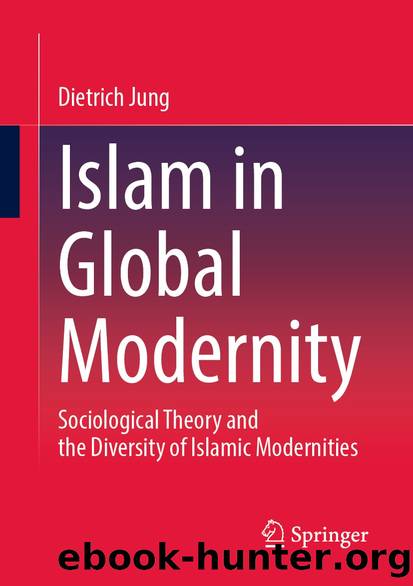Islam in Global Modernity by Dietrich Jung

Author:Dietrich Jung
Language: eng
Format: epub
ISBN: 9783658399542
Publisher: Springer Fachmedien Wiesbaden
5.4 Conclusions: Max Weber and Islam
In his book Weber and Islam, Bryan Turner put forward the thesis that in Max Weberâs analysis, the patrimonial nature of Muslim political institutions had prevented social conditions that would have been necessary for the development of modern capitalist living conditions in the Islamic world (Turner 1974, p. 2). There would have been a lack of predictable justice, urban centers, and an economy that was not under the influence of state interests (1974, p. 15). In fact, the comparatively few pages that Max Weber devoted to Islam in his comparative cultural studies had the goal of describing a deficiency, that is, what Islam lacked in comparison to Europe (cf. Paul 2003; Leder 2020). In his assessment of Islam as a âwarrior religionâ, Weber probably followed the work of Julius Wellhausen, who was primarily known for his studies on Muhammad in Medina and the early expansion of the Muslims.22 In these studies, Wellhausen relied mainly on the so-called Futuh literature as his primary sources, which was âpoetry with historical backgroundâ.23 The goal of these texts was the âglorification of the Arab warriors from the time of the conquestsâ (Paret 1981, pp. 736â742). In this literary genre, military service also appeared as a form of worship (Paret 1930, p. 183). The previously mentioned heyday of science in Baghdad or the expansion of Islam through complex trade relations, which created a globally interconnected intellectual space, the dar al-islam, was not in Weberâs sights. Against the background of the historical development of the Islamic empires between the 8th and 11th centuries, the image of an archaic âpolitical Islamâ with the warrior as its religious ideal (Weber 1972, p. 375) therefore almost sounds like a caricature of historical reality. The French historian Maurice Lombard described this period of Islamic empires as characterized by a remarkably homogeneous urban culture with âa wide exchange of people, goods and ideasâ (Lombard 1992, p. 28). For Lombard, the âconstitution of the Islamic worldâ was above all the formation of a huge, common market and not the religious revelation of the Koran carried into the world by warriors, as we encounter it in Max Weberâs writings (Lombard 1992, p. 131).
In âEconomy and Societyâ Max Weber also dealt with the âIslamic cityâ. Here he compares Mecca with the development of urban cultures in Europe. The data basis used by Weber are the two books on the âholy cityâ published by Snouck Hurgronje. These go back to Hurgronjeâs notesââSnouck Hurgronjeâs vivid representationâ (Weber 1972, p. 739)âwith which he began during his six-month stay in Mecca in 1885. There Hurgronje appeared as a Muslim student under the name Abdel Ghaffar and took part in the student circle of the Meccan Sheikh Ahmad Zayni Dahlan (1817â1886). Dahlanâs stories then went into Hurgronjeâs books about the city (Hurgronje 1888, 1889). The Dutch orientalist documented the orally transmitted history of Mecca as conveyed by the Shaafiâi sheikh Dahlan to his students (cf. Freitag 2003). But the history of Mecca, apart from the role of the pilgrimage, is a history of the urban periphery in Islam.
Download
This site does not store any files on its server. We only index and link to content provided by other sites. Please contact the content providers to delete copyright contents if any and email us, we'll remove relevant links or contents immediately.
| Africa | Americas |
| Arctic & Antarctica | Asia |
| Australia & Oceania | Europe |
| Middle East | Russia |
| United States | World |
| Ancient Civilizations | Military |
| Historical Study & Educational Resources |
Cecilia; Or, Memoirs of an Heiress — Volume 1 by Fanny Burney(32063)
Cecilia; Or, Memoirs of an Heiress — Volume 3 by Fanny Burney(31458)
Cecilia; Or, Memoirs of an Heiress — Volume 2 by Fanny Burney(31409)
The Secret History by Donna Tartt(18166)
Sapiens: A Brief History of Humankind by Yuval Noah Harari(13991)
Leonardo da Vinci by Walter Isaacson(12804)
The Radium Girls by Kate Moore(11621)
Sapiens by Yuval Noah Harari(5124)
How Democracies Die by Steven Levitsky & Daniel Ziblatt(4959)
The Wind in My Hair by Masih Alinejad(4844)
Homo Deus: A Brief History of Tomorrow by Yuval Noah Harari(4690)
Endurance: Shackleton's Incredible Voyage by Alfred Lansing(4507)
Man's Search for Meaning by Viktor Frankl(4278)
The Silk Roads by Peter Frankopan(4274)
Millionaire: The Philanderer, Gambler, and Duelist Who Invented Modern Finance by Janet Gleeson(4101)
The Rape of Nanking by Iris Chang(4023)
Hitler in Los Angeles by Steven J. Ross(3799)
The Motorcycle Diaries by Ernesto Che Guevara(3788)
Joan of Arc by Mary Gordon(3784)
